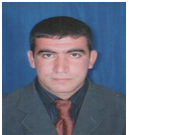Salhi Hicham CHAFAIN.
Evaluation of the thermal conductivity of nanofluids using statistical analysis methods. Nanoscience and Technology: An International Journal. 2022;13 (4) :45-61.
Abstract
In this study, a statistical analysis method such as cluster analysis was used to group the effective ther- mal conductivity models of nanofluids. Ten models were selected for each nanofluid Al2O3, SiO2, TiO2, Cu, Ag, and Al, and then four models were proposed to estimate the thermal conductivity of nanoflu- ids. For the proposed models, the volume fraction is regarded as the best predictor. The nine statistical indicators and global performance indicators are calculated to evaluate different suggested models. For all used nanofluids, the recommended Global Performance Index (GPI) for the model ranges from –6.4197 to 2.5742. The highest GPI represents the best performing model.
Hicham. S.
Evaluation of the Spatial Distribution of the Annual Extreme Precipitation Using Kriging and Co-Kriging Methods in Algeria Country. In: Climate Change in Asia and Africa:Examining the Biophysical and Social Consequences, and Society's Responses. IntechOpen ; 2022.
Publisher's VersionAbstract
In this chapter, we have conducted a statistical study of the annual extreme precipitation (AMP) for 856 grid cells and during the period of 1979–2012 in Algeria. In the first step, we compared graphically the forecasts of the three parameters of the generalized extreme value (GEV) distribution (location, scale and shape) which are estimated by the Spherical model. We used the Cross validation method to compare the two methods kriging and Co-kriging, based on the based on some statistical indicators such as Mean Errors (ME), Root Mean Square Errors (RMSE) and Squared Deviation Ratio (MSDR). The Kriging forecast error map shows low errors expected near the stations, while co-Kriging gives the lowest errors on average at the national level, which means that the method of co-Kriging is the best. From the results of the return periods, we calculate that after 50 years the estimated of the annual extreme precipitation will exceed the maximum AMP is observed in the 33-year.
3- CHAFAI Nadjib SH.
Numerical Study of Natural Convection of Nanofluids in an Inclined Flat Bottom Flask Using Finite-Volume Approach. Iran. J. Chem. Chem. Eng. 2022;41 (7).
Abstract
In this work, we study numerically the natural convection of NanoFluids (NF) in an inclined flat bottom flask; it is one of the laboratory flasks used in organic chemistry synthesis. The main reason for this study is to enhance the thermal properties of the reaction medium inside the flat bottom flask and to ameliorate the rate of chemical reactions using nanofluids. The flat bottom wall is maintained at a constant high-temperature Th. While the top, left and right walls of the cavity are maintained at a low-temperature TL. The NF comprises Cu and Al2O3 NanoParticles (NP) suspended in pure water. The governing equations are solved numerically using the finite-volume approach and formulated using the Boussinesq approximation. In this simulation we examined the effects of the NP volume fraction (φ) from 0% to 5%, the Rayleigh number from 103 to 106, the various inclination angles of enclosure (γ=0°,5°,10°, 15°) and the NF type (Cu and Al2O3) on the flow streamlines, isotherm distribution, and Nusselt number. The obtained results show that the addition of Cu and Al2O3 NP increases the mean Nusselt number which enhances the heat transfer in the flat bottom flask and causes significant changes in the flow pattern. In addition, the mean Nusselt number is increased with increasing the Rayleigh number and the volume fraction, and the best results have been obtained from the Cu nanofluid. Also, as the inclination angle increases the mean Nusselt number decreases, and the highest value of the Nusselt number was obtained for a vertical enclosure (γ=0°). The obtained streamlines are mostly symmetric and their values
are generally increased by increasing the Rayleigh number and volume fractions of NPs. Besides, the obtained isotherms generally follow the geometry of the flat bottom flask.
